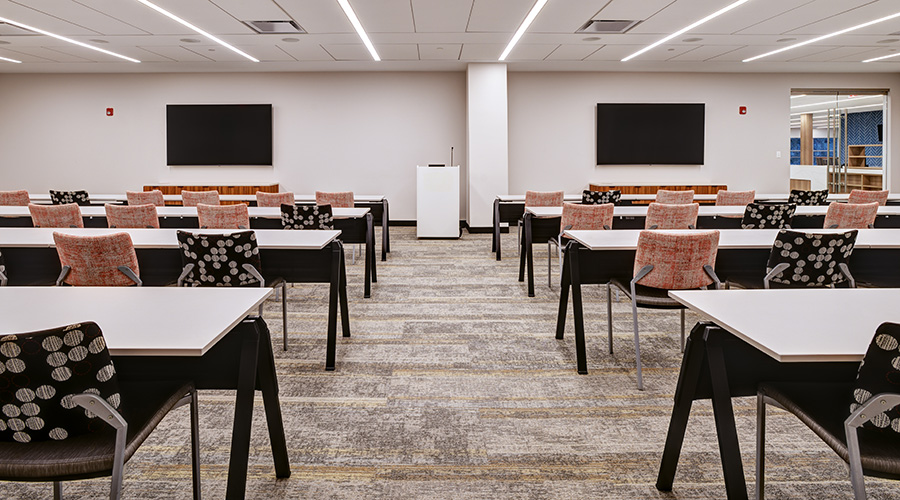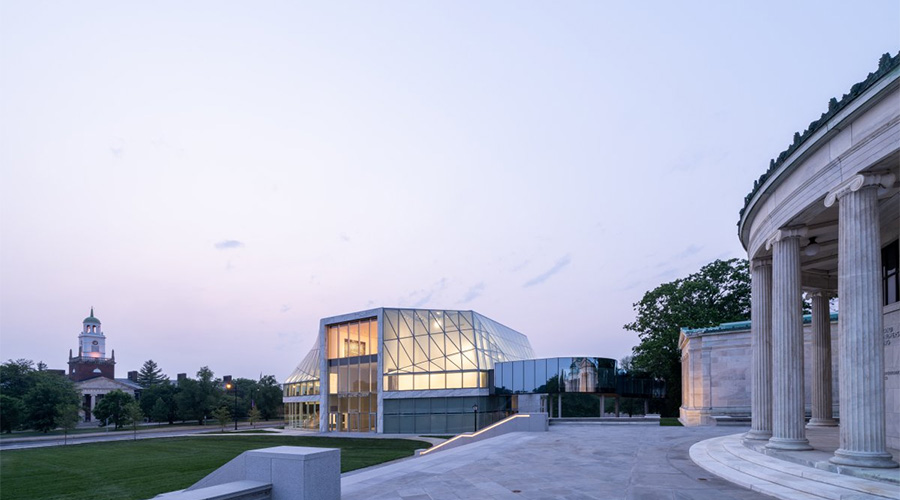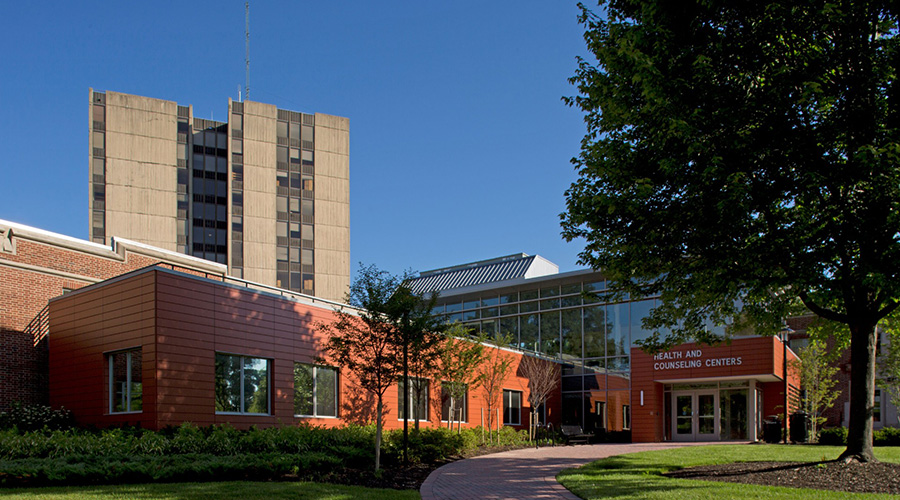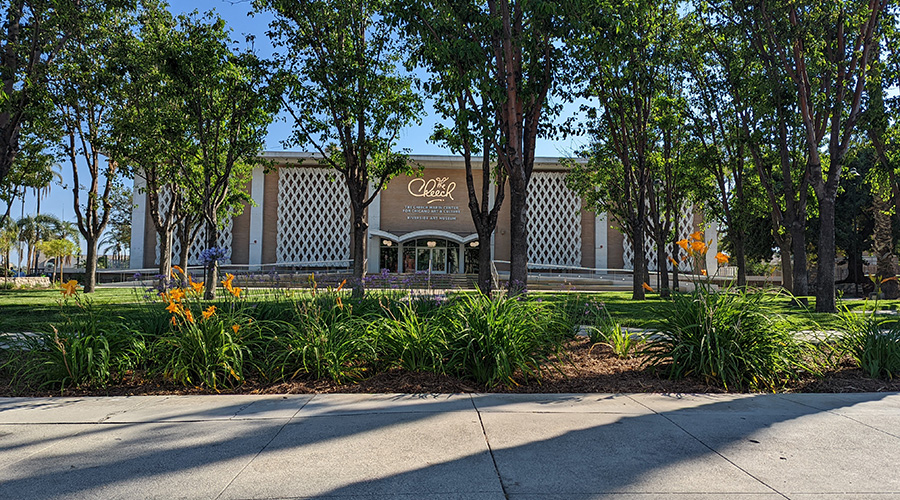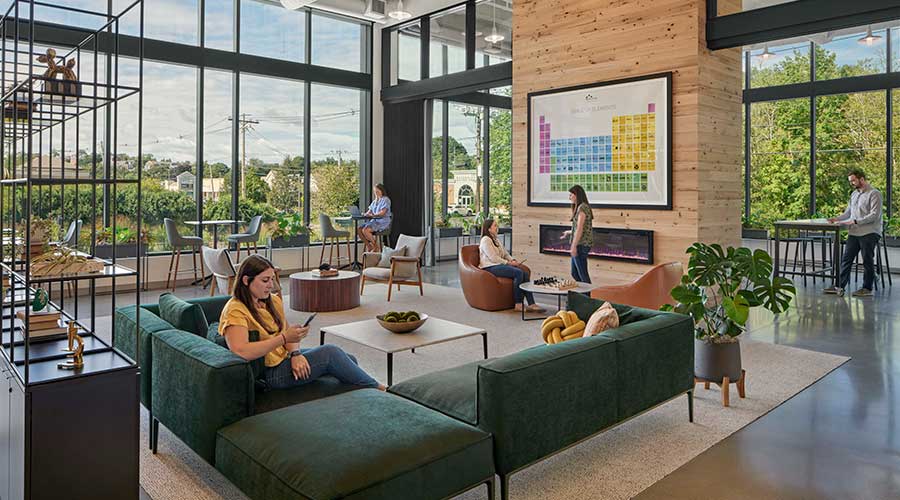Facelift and Expansion Revives Buffalo Art Museum
Designers faced challenges of renovating multiple buildings while expanding museum’s grounds concurrently.
By Maura Keller, Contributing Writer
Working within the context of historic, century-old buildings, while striving to embed fresh, innovative, state-of-the-art design elements was the task that architect OMA, in collaboration with Cooper Robertson, faced in the recent renovation and expansion of the Buffalo AKG Art Museum in Buffalo, New York.
As Jason Cadorette, AIA, senior associate at Cooper Robertson explained, the renewed and expanded Buffalo AKG Art Museum showcases the economic and cultural renaissance Western New York is experiencing and embodies through transformative designs that “allow for full accessibility and visitor engagement, advancing a more inclusive, interactive, and impactful visitor-centered museum experience.”
“Prior to this 2023 expansion by architect OMA in collaboration with Cooper Robertson, the Buffalo AKG Art Museum was enlarged twice during its 161-year history, the first time in 1905 with the museum’s first permanent home and then again in 1962,” Cadorette says.
Expansion details
This latest expansion, the Jeffrey E. Gundlach Building, adds 30,000 square feet of exhibition space, including an additional state-of-the-art space for presenting specialexhibitions.
Jamie Robideau, director of facilities, planning and managementof the Buffalo AKG Art Museum, further points out that because the buildings are listed on the National Register of Historic Places, every design and construction decision involved balancing present-day needs and standards with the priorities of historical preservation.
Specifically, along with high-efficiency LED lighting, the new building’s digital frit, or printing, works with interior shading and HVAC to efficiently control solar heat gain and ensure thermal comfort for all visitors.
“As a transparent counterpart to the adjacent historical buildings, the design of a wraparound promenade visually connects the interior of the building with the surrounding Frederick Law Olmsted Delaware Park,” Cadorette says.
Another key element to the museum’s renovation is the newJohn J. Albright Bridge that connects the Gundlach Building to the museum campus’ existing Wilmers Building. As Cadorette describes, the bridge curves around a grove of historic oak trees preserved on the site and facilitates pedestrian movement and art handling between the gallery spaces in the new and existing buildings. Major updates to the Wilmers Building enhance visitor comfort and gallery acoustics, and ADA compliance.
The project also features a new underground parking structure and transformation of the surface parking lot into a vibrant green landscape, including 36,400 square feet of new green space.
“With that, new entry and exit points on the east façade of the museum’s 1962 Seymour H. Knox Building were designed by Gordon Bunshaft,” Cadorette says. The once open outdoor courtyard now includes a site-specific installation that encloses the courtyard for year-round use. Renovation of the interior spaces introduced 3,800 square feet of new classroom studios, a new restaurant, and a renovated 350-seat auditorium.
“The transformation of the museum to what it is today brings to life the incredible vision of the museum director, board, and staff. Their vision to create a world-class museum while remaining dedicated to the community is one of the project's biggest success stories,” Cadorette says. “The museum is now able to showcase its art in the expanded gallery spaces and cater to schools in its new education wing. The Ralph Wilson Courtyard is free to the public and hosts many events, fostering a sense of community. Overall, this transformative project did what it set out to do and supports the community in which it lives.”
Robideau adds that perhaps the most immediately impactful success of the museum’s renovation is how the entire campus is now significantly more welcoming to the public and pedestrian traffic. The Ralph Wilson Town Square, under Common Sky, which is free of admission charges, has become a bustling community hub.
“New multifunctional spaces like the Sculpture Terrace in the Gundlach Building now exist throughout the museum and enable us to conduct a wide array of programs and events,” Robideau says. “In just our first year alone, the Great Lawn has been the site of multiple free, outdoor concerts that have been attended by thousands of people from across Western New York.”
Embracing challenges
A project of this magnitude is bound to face some unique challenges. As Cadorette explains, the expansion involved eight major building projects happening simultaneously –including renovations of buildings constructed in the 1900s to 1960s. Together, with the new construction project, the entire project team had to continually shift their focus from one part of the project to the next, as each building was constructed differently and required different building techniques.
“Often, we worked with the same contractor and had to walk them through the reasons why we had to build slightly differently in each building,” Cadorette says.
For example, the Wilmers Building, built in 1905, is a masonry load bearing constructionand includes terracotta tile floors, whereas the Knox Building, built in 1962, was a completely different steel and concrete structure. Each building’s unique mechanical distribution and spatial characteristics affected the retention of correct temperature and humidity for art.
“The facilities team programmatically requiredone central plant for the campus, with the art requiring the same temperature and humidity set points,” Cadorette says. “With that, the design team, in collaboration with the museum, developed different strategies for each building to ensure the efficient operation of the mechanical plant by the facilities teams, ultimately functioning as one unit.”
The building program as an art museum would typically require that the structure be a closed container for art. So as Robideau points out, the challenge to the architect was to make it both welcoming and open while also ensuring that art would be protected from the harmful effects of direct sunlight. Also, to make improvements to the existing facilities, the design team constantly balanced the different but related priorities of preserving the architecturally significant structures and bringing them in line with modern standards.
Lessons learned
So, what can other leaders within the facilities management space learn from the success of the Buffalo AKG Art Museum’s renovation?
“As the owner, one has to have perfect clarity about one’s needs and desires, and communicate them as clearly as possible to the design team,” Robideau says. “We impressed upon the design team early on the importance of certain essential elements of the project, such as the path for the transportation of artworks, and that gave structure to the rest of our plans, which continued to develop collaboratively well into the construction process.”
Cadorette further points out that when designing a facility that oversees multiple buildings, it’s essential to work as a team and have input from the client’s facilities team. He says that the facilities team’s valuable knowledge about how the plants operate and the way the existing buildings function is critical to implementing quality upgrades.
“Effective communication between the client and the design team is crucial for the success of the project. Involving the end users in decision-making also ensures they are invested in the project and familiar with the new equipment,” Cadorette says. “My advice, therefore, is for the facilities team to be actively involved in the design and decision-making process of any project. Their insight is invaluable and at the end of the day, they will be left with the running of the museum, so it’s best that it’s designed with their participation.”
For the Buffalo AKG Art Museum, the project entailed more than 100 different organizations, including over 27 design consultants and more than 32 different contractors. As Cadorette points out, this can be overwhelming for an institutional client who is not in the business of building buildings.
“Assembling our team involved years of research. We structured our design competition such that the winner was not a specific design, but rather an architecture firm that demonstrated the ability to be flexible and to develop dynamic solutions to an array of design challenges,” Robideau says. Owner’s representation is also essential, in order to avoid overtaxing institutional staff who may not have the training to navigate a major construction project.
Collaboration, dialogue, and flexibility are essential to any effective project team. “Together, we faced a variety of unanticipated challenges, and we were only able to navigate them toward sustainable solutions by regularly meeting at the table,” Robideau adds.
Of course, choosing the right architect is an important first step as well as an owner's representative, who can lead the museum through the design and construction process. “To be a successful team in the design and construction process, group leaders need to put in place effective strategies for solving problems as they happen,” Cadorette says.
Expansions and renovations take years of planning and construction because they require a significant amount of time and cooperation between all parties. That’s why Carodette always advises clients to carefully consider the team they want to work with for the next few years, sometimes a decade, because, in a sense, you are choosing co-workers that become a part of your daily working life.
“There will be stressful times and being able to work through them with people you respect and trust helps make the process fun and enjoyable – and ultimately, successful,” Carodette says.
For Robideau, it’s important to expect the unexpected. To the greatest extent possible, plan for the unexpected. “There will inevitably be new problems or challenges that arise with what might otherwise seem to be unremarkable or uncomplicated aspects of a given project,” Robideau says. “Sometimes, the only certainty is uncertainty.”
Maura Keller is a freelance writer based in Plymouth, Minnesota.
Related Topics:







